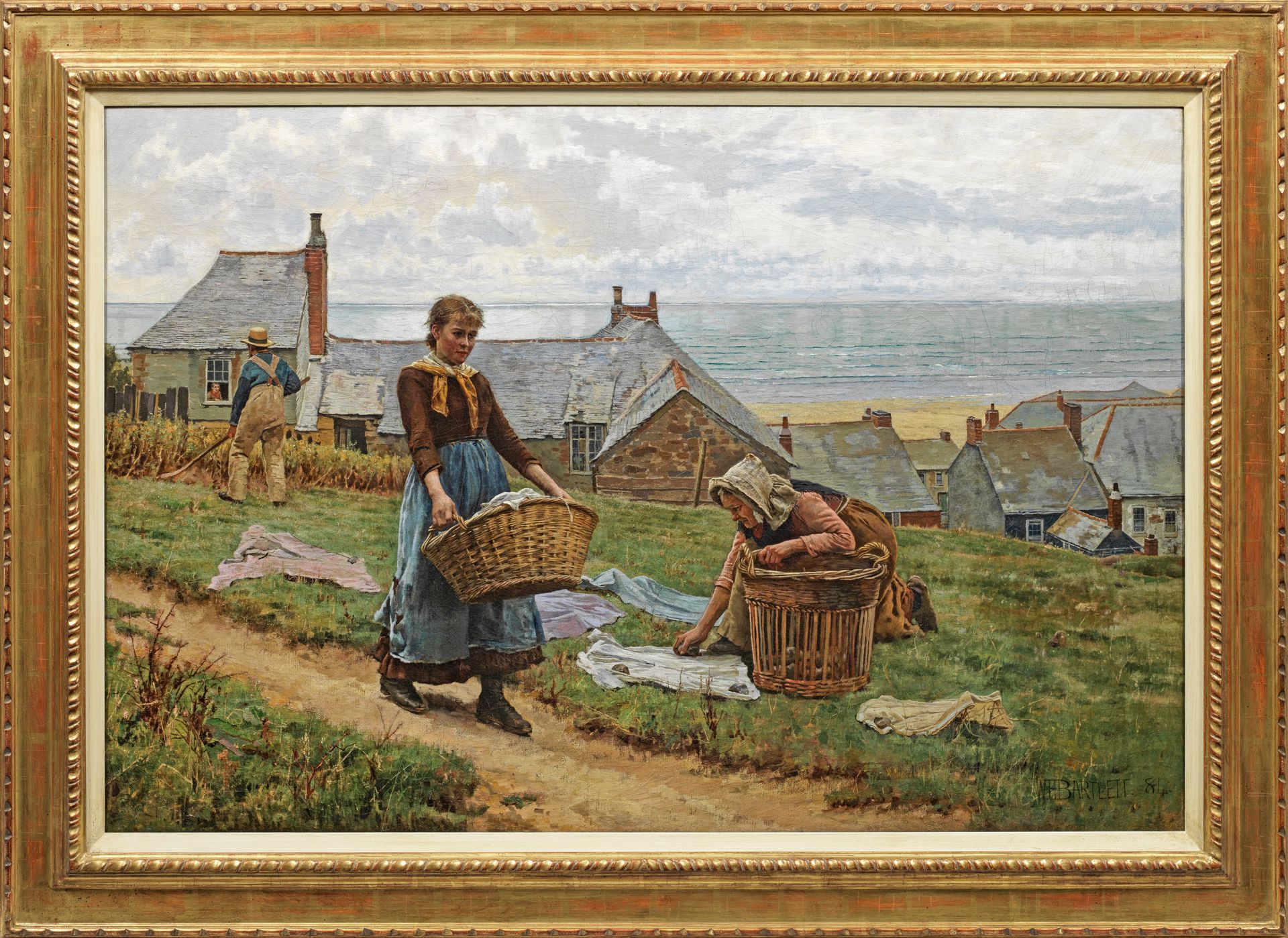Description
William Henry Bartlett (1858 London - 1932 ibid.) "A bad wind for fish, but a good one for drying" (A bad wind for fishing, but a good day for drying). Original title In this early major work, Bartlett depicts a realistic open-air everyday scene in the picturesque fishing village of St. Ives in Cornwall, which he first visited in 1884 and immediately set to work. In addition to the landscape and the village itself, he observed the lives of the fishermen catching sand eels as well as those of the other villagers and, not least, the local women. Bartlett shows here how, in calm weather, an elderly woman and a young woman lay the white laundry on a meadow to dry and bleach, weighing it down with stones. While the women empty their heavy baskets, an elderly fisherman continues to mow a section of the meadow, watched closely by a woman looking out of the window of a nearby cottage. The view extends beyond the fishermen's cottages and the beach to the calm sea, with the silver-grey cloudy sky providing a subtle harmony of color without strong contrasts. William Henry Bartlett, the son of an art dealer, went to Paris in the late 1870s to study at the Académie Julian under William Adolphe Bouguereau and at the École des Beaux-Arts under Jean-Léon Gérôme. However, Jules Bastien-Lepage and his Plein Air Naturalism were a major influence on Barlett, as they were on many other painters of his generation. The French painter had also advised his followers to discover their own "coin de terre". After returning to London in 1880, Bartlett discovered not only St. Ives but also the west of Ireland in particular in the following years. He developed an intense interest in Irish rural life, particularly the rugged landscapes where people struggled to survive, and this was reflected in a number of his paintings. In 1880 Bartlett exhibited for the first time at the Royal Academy in London, which he regularly attended thereafter; in 1889 he won a silver medal at the Universal Exhibition in Paris. Oil on canvas; signed and dated on the reverse. (18)84. Verso on stretcher handwritten inscr. and numbered. 82 cm x 122 cm. Frame. Provenance: probably Jacob Hecht Kunst- und Auktions-Haus, Berlin, auction 2.-3.10.1928, lot 739 (there dated 1881); thereafter in family ownership in Berlin for three generations; auction Ketterer, Munich, 17.06.2021, lot 46. Literature/Exhibition: 116th exhibition of the Royal Academy, London, 1884, no. 51. Oil on canvas. Signed and dated (18)84. Exhibited in the Royal Academy, London, 1884, No. 51.
1779
William Henry Bartlett (1858 London - 1932 ibid.) "A bad wind for fish, but a good one for drying" (A bad wind for fishing, but a good day for drying). Original title In this early major work, Bartlett depicts a realistic open-air everyday scene in the picturesque fishing village of St. Ives in Cornwall, which he first visited in 1884 and immediately set to work. In addition to the landscape and the village itself, he observed the lives of the fishermen catching sand eels as well as those of the other villagers and, not least, the local women. Bartlett shows here how, in calm weather, an elderly woman and a young woman lay the white laundry on a meadow to dry and bleach, weighing it down with stones. While the women empty their heavy baskets, an elderly fisherman continues to mow a section of the meadow, watched closely by a woman looking out of the window of a nearby cottage. The view extends beyond the fishermen's cottages and the beach to the calm sea, with the silver-grey cloudy sky providing a subtle harmony of color without strong contrasts. William Henry Bartlett, the son of an art dealer, went to Paris in the late 1870s to study at the Académie Julian under William Adolphe Bouguereau and at the École des Beaux-Arts under Jean-Léon Gérôme. However, Jules Bastien-Lepage and his Plein Air Naturalism were a major influence on Barlett, as they were on many other painters of his generation. The French painter had also advised his followers to discover their own "coin de terre". After returning to London in 1880, Bartlett discovered not only St. Ives but also the west of Ireland in particular in the following years. He developed an intense interest in Irish rural life, particularly the rugged landscapes where people struggled to survive, and this was reflected in a number of his paintings. In 1880 Bartlett exhibited for the first time at the Royal Academy in London, which he regularly attended thereafter; in 1889 he won a silver medal at the Universal Exhibition in Paris. Oil on canvas; signed and dated on the reverse. (18)84. Verso on stretcher handwritten inscr. and numbered. 82 cm x 122 cm. Frame. Provenance: probably Jacob Hecht Kunst- und Auktions-Haus, Berlin, auction 2.-3.10.1928, lot 739 (there dated 1881); thereafter in family ownership in Berlin for three generations; auction Ketterer, Munich, 17.06.2021, lot 46. Literature/Exhibition: 116th exhibition of the Royal Academy, London, 1884, no. 51. Oil on canvas. Signed and dated (18)84. Exhibited in the Royal Academy, London, 1884, No. 51.
